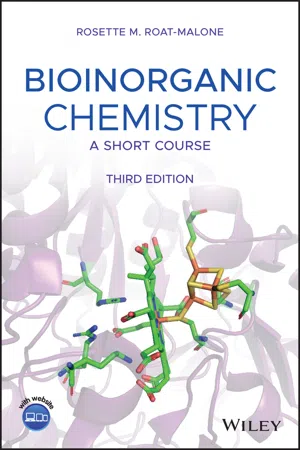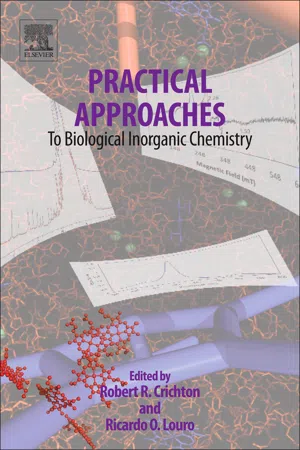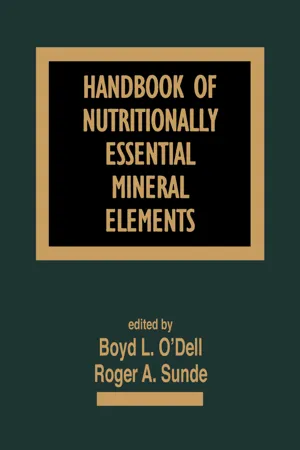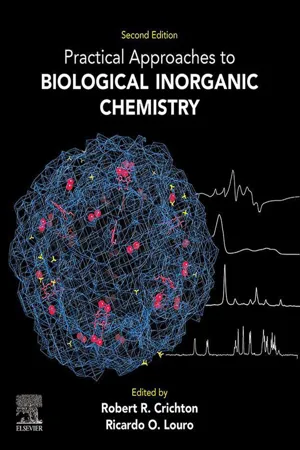Biological Sciences
Inorganic Ions
Inorganic ions are charged particles that do not contain carbon and are essential for various biological processes. They play crucial roles in maintaining osmotic balance, transmitting nerve impulses, and regulating muscle contractions. Common inorganic ions in biological systems include sodium (Na+), potassium (K+), calcium (Ca2+), and chloride (Cl-). These ions are involved in maintaining the body's homeostasis and are vital for life processes.
Written by Perlego with AI-assistance
Related key terms
Related key terms
1 of 4
Related key terms
1 of 3
4 Key excerpts on "Inorganic Ions"
- eBook - ePub
Bioinorganic Chemistry
A Short Course
- Rosette M. Roat-Malone(Author)
- 2020(Publication Date)
- Wiley(Publisher)
1 INORGANIC CHEMISTRY AND BIOCHEMISTRY ESSENTIALS1.1 INTRODUCTION
Bioinorganic chemistry involves the study of metal species in biological systems. As an introduction to the basic inorganic chemistry is needed for understanding bioinorganic topics, this chapter will discuss the essential chemical elements, the occurrences and purposes of metal centers in biological species, the geometries of ligand fields surrounding these metal centers and ionic states preferred by the metals. The occurrence of organometallic complexes and clusters in metalloproteins will be discussed briefly and an introduction to electron transfer in coordination complexes will be presented. Since the metal centers under consideration are found in a biochemical milieu, basic biochemical concepts, including a discussion of proteins and nucleic acids, are presented later in this chapter.1.2 ESSENTIAL CHEMICAL ELEMENTS
Chemical elements essential to life forms can be broken down into four major categories: (i) bulk elements (H/H+ , C, N, O2− /O2 −· /O2 2− , P, and S/S2− ); (ii) macrominerals and ions (Na/Na+ , K/K+ , Mg/Mg2+ , Ca/Ca2+ , Cl− , PO4 3− , and SO4 2− ); (iii) trace elements (Fe/FeII /FeIII /FeIV , Zn/ZnII , and Cu/CuI /CuII CuIII ); and (iv) ultratrace elements, that comprise nonmetals (F/F− , I/I− , Se/Se2− , Si/SiIV , As, and B) and metals (Mn/MnII /MnIII /MnIV , Mo/MoIV /MoV /MoVI , Co/CoII / CoIII , Cr/CrIII /CrVI , V/VIII / VIV / VV /, NiI / NiII / NiIII /, Cd/Cd2+ , Sn/SnII /SnIV , Pb/Pb2+ , and Li/Li+ ). In the preceding classification, only the common biologically active ion oxidation states are indicated (see references [1 , 2d ] for more information). If no charge is shown, the element predominately bonds covalently with its partners in biological compounds, although elements such as carbon (C), sulfur (S), phosphorus (P), arsenic (As), boron (B), and selenium (Se) have positive formal oxidation states in ions containing oxygen atoms; i.e. S = +6 in the SO4 2− ion or P = +5 in the PO4 3− ion. The identities of essential elements are based on historical work done by Klaus Schwarz in the 1970s [3 ]. Other essential elements may be present in various biological species. Essentiality has been defined by certain criteria: (i) a physiological deficiency appears when the element is removed from the diet; (ii) the deficiency is relieved by the addition of that element to the diet; and (iii) a specific biological function is associated with the element [4 ]. Table 1.1 - Robert R. Crichton, Ricardo O. Louro(Authors)
- 2012(Publication Date)
- Elsevier(Publisher)
Chapter 1 An Overview of the Roles of Metals in Biological SystemsRobert R. Crichton, Batiment Lavoisier, Université Catholique de Louvain, Louvain-la-Neuve, BelgiumChapter OutlineIntroduction: Which Metals Ions and Why? Some Physicochemical Considerations on Alkali MetalsNa+ and K+ – Functional Ionic GradientsMg2+ – Phosphate MetabolismCa2+ and Cell SignallingZinc – Lewis Acid and Gene Regulator Iron and Copper – Dealing with Oxygen Ni and Co – Evolutionary Relics Mn – Water Splitting and Oxygen Generation Mo and V – Nitrogen FixationIntroduction: Which Metals Ions and Why?
In the companion book to this one, ‘Biological Inorganic Chemistry 2nd edition’ (Crichton, 2011 ), we explain in greater detail why life as we know it would not be possible with just the elements found in organic chemistry – namely carbon, oxygen, hydrogen, nitrogen, phosphorus and sulfur. We also need components of inorganic chemistry as well, and in the course of evolution nature has selected a number of metal ions to construct living organisms. Some of them, like sodium and potassium, calcium and magnesium, are present at quite large concentrations, constituting the so-called ‘bulk elements’, whereas others, like cobalt, copper, iron and zinc, are known as ‘trace elements’, with dietary requirements that are much lower than the bulk elements.Just six elements – oxygen, carbon, hydrogen, nitrogen, calcium and phosphorus – make up almost 98.5% of the elemental composition of the human body by weight. And just 11 elements account for 99.9% of the human body (the five others are potassium, sulfur, sodium, magnesium and chlorine). However, between 22 and 30 elements are required by some, if not all, living organisms, and of these are quite a number are metals. In addition to the four metal ions mentioned above, we know that cobalt, copper, iron, manganese, molybdenum, nickel, vanadium and zinc are essential for humans, while tungsten replaces molybdenum in some bacteria. The essential nature of chromium for humans remains enigmatic.- Boyd L. O'Dell, Roger A. Sunde, Boyd L. O'Dell, Roger A. Sunde(Authors)
- 1997(Publication Date)
- CRC Press(Publisher)
71 .)B. Specific Ion Interactions
While the discussion of in-vivo ion interactions was separated into major and minor elements, such distinction is less pertinent in the case of ion channels because they accommodate both classes of ions at catalytic concentrations. The commonly recognized ion channels are permeable primarily to ions that are nutritionally classified as major elements, including calcium, sodium, potassium, and chloride. Within the cell these ions perform regulatory roles at extremely low concentrations, levels that are highly analogous to those at which the minor elements perform catalytic or cofactor roles. In this sense the major elements serve as catalysts or second messengers. For example, the free calcium ion concentration in extracellular fluids, such as plasma, is approximately 10,000 times the intracellular concentration, 1000 μM versus 0.1 μM. The intracellular concentration of calcium may rise as much as 10-fold following cell stimulation, the surge or “puff” serving as a cell signal or second messenger. Interactions at the ion channels involve minor as well as major elements. It must be recognized that the interactions observed have been made with in-vitro systems, and there is no evidence that they are either significant or applicable in vivo. Specific examples of in-vitro interactions are discussed by ion channel.1. Calcium Channel
Calcium enters cells by way of both voltage- and ligand-gated channels, and by a process of facilitated diffusion (75 –77 ). Voltage-operated calcium channels are found primarily in excitable cells, such as neurons in the CNS. The movement of calcium through these channels is inhibited by several divalent cations, notably the essential elements magnesium and manganese (75 ). Examples of ions that inhibit both voltage-gated and ligand-gated calcium channels are listed in Table 3- Robert R. Crichton, Ricardo O. Louro(Authors)
- 2019(Publication Date)
- Elsevier(Publisher)
Chapter 1An overview of the role of metals in biology
Robert R. Crichton, Catholic University of Louvain, Louvain-la-Neuve, BelgiumAbstract
After briefly outlining the essential elements for biological systems, we discuss the functions of the essential metal ions, as well as touching on their potential toxicity. Toxic metal ions, which have often been introduced into our environment are discussed, and the chapter concludes with some examples of the use of metal ions in diagnostic and therapeutic applications.Keywords
Essential metal ions; toxic metal ions; diagnostic metal ions; therapeutic metal ionsOutline- Introduction 1
- Essential metal ions and their functions 2
- Toxic metals 10
- Metals in diagnosis and therapeutics 13
- References 15
- Further reading 16
Introduction
Metals play many different roles in the biological world, whether by their participation in essential biological processes, as toxic constituents of our environment, or as indispensable diagnostic and therapeutic agents in human medicine. Only a limited number of metal ions are essential for most living organisms (Fig. 1.1 ), and this short introduction begins by illustrating the biological importance of metals, not only in vital processes such as intermediary metabolism, electron transfer, respiration, and photosynthesis, but also in neurotransmission, cell signaling, apoptosis, and fertilization.Figure 1.1 A biological periodic table of the elements indicating the essential elements. The essential elements for most forms of life are shown in black with the exception of chromium (Cr), which is shown with an upward diagonal pattern, and essential elements that are more restricted for some forms of life shown in gray.Source: Reproduced from Maret, W., 2016. The metals in the biological periodic system of the elements: concepts and conjectures. Int. J. Mol. Sci. 17, pii:E66. doi:10.3390/ijms17010066
Index pages curate the most relevant extracts from our library of academic textbooks. They’ve been created using an in-house natural language model (NLM), each adding context and meaning to key research topics.
Explore more topic indexes
Explore more topic indexes
1 of 6
Explore more topic indexes
1 of 4



